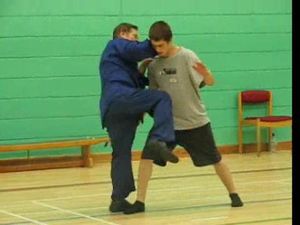Kneeing
A knee strike (commonly referred to simply as a knee) is a strike with the knee, either with the kneecap or the surrounding area. Kneeing is a disallowed practice in many combat sports, especially to the head, or to any bodypart of a downed opponent. Styles such as Muay Thai and several mixed martial arts organizations allow kneeing depending on the positioning of the fighters. Knee strikes (particularly to the groin for males) are generally agreed to be effective self-defense maneuvers.
Straight knee strike
The straight knee (also known as a front knee) is a typical knee strike, and involves thrusting the front of the knee into the head or body of an opponent. The straight knee can be applied from a stand-up position both when the combatants are separated, or when they are clinching. A particularly effective clinching position for throwing front knee is the double collar tie, where the head of the opponent is controlled. On the ground, front knees can be effective from a few top positions such as the Side control and north-south position. Typical targets for the front knee include the head, hips, ribs, solar plexus, stomach and thighs. In Muay Thai, a double collar tie with a front knee to the face was traditionally called Hak Kor Aiyara.
Curved Knee Strike
The curve knee (also sometimes called a side knee) is similar to the front knee except that it does not use a forward thrusting motion, but is instead rotated from the outside. Whereas the front knee needs some space in between the combatants to be performed, the curved knee can be executed from a minimal distance, such as in a close clinch. Typical targets include floating ribs, hips, and the side of the abdomen.
Flying Knee Strike
A flying knee (known as hanuman thayarn in Muay Thai, and sometimes called a jumping knee) is a knee strike very similar to a front knee, except that it is performed in stand-up fighting by jumping, and often by rushing towards the opponent. A more reckless application of the flying knee strike can be applied by rotating the body so that the side of the knee strikes the opponent, used more as an offensive pushing attack rather than a concussive KO attack. Generally, flying knee strikes can be effectively applied when the opponent is off-balanced, recovering from previous strikes, or as a counter to a strike by the opponent.
Use In Combat Sports
Provided that it makes impact with the head, a flying knee offers substantial momentum and knockout power. This spectacular strike is a crowd-pleaser in fighting sports such as K-1 and UFC. In one UFC bout, James Irvin knocked out Terry Martin with a flying knee; Martin was unresponsive for three minutes and left on a stretcher. At a rfecent event, Norifumi Yamamoto knocked out Kazuyuki Miyata with a flying knee at four seconds into the first round. Kickboxer Remy Bonjasky is known for his flying knees. Japanese professional wrestler Tomomi Tsuruta also used a jumping knee as one of his finishing moves.
Chat rooms • What links here • Copyright info • Contact information • Category:Root
